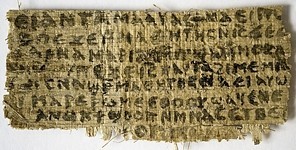
According to an , an ancient manuscript claiming that Jesus had a wife has just been discovered. I’ll tackle this new discovery with some Q&A.
What is this new find?
Karen King, the Gnostic scholar who published the manuscript, has titled it the Gospel of Jesus’ Wife. It is a very small fragment, only 12 partial lines, of an ancient Gnostic book. The fragment, written in Coptic, dates from the fourth century, but it is a copy of an older book, perhaps written in the late second century. According to the fragment, Jesus refers to “my wife.”
Is the manuscript genuine?
It’s too early to tell. When manuscripts are discovered, it usually takes some time of examination and scholarly vetting before forgeries are discovered. There are some concerns about Gospel of Jesus’ Wife’s unknown provenance and history of ownership, but the initial reports make it seem likely that this is a real fourth-century Gnostic document. That doesn’t mean that the document is true or has anything to do with Jesus!
[Update: in the months following the publication of the manuscript, significant evidence came to light strongly suggesting that it is a modern forgery. It is written in the wrong dialect of Coptic for the supposed date of writing; it makes grammar mistakes unlikely for a native speaker; all of the lines could have been put together by a sort of cut-and-paste method from the Gospel of Thomas; some of the line divisions strongly suggest that it is dependent on a recent publication; and most significantly, it was found with another document, written by the same "scribe," that is almost certainly a forgery. See my follow-up post]
How is this related to the so-called Gnostic gospels?
The Gnostics wrote a number of short collections of sayings that they attributed to Jesus: the Gospel of Philip, Gospel of Judas, Gospel of Mary Magdalene, and others. Technically, these are not really gospels, at least when compared with the canonical gospels. The four gospels in the New Testament are full biographies of Jesus, directly tied to eyewitness accounts, and written within 25 to 60 years of Jesus’ death and resurrection. The Gnostic gospels, in contrast, are short collections of sayings, with little or no biographical material. They are written by people more than a century removed from Jesus, with no connection to the eyewitnesses. Generally, these works are easily identified because they try to make Jesus sound like a Gnostic. This newly discovered fragment has a few lines that sound like the Gospel of Philip, the Gospel of Thomas, and the Gospel of Mary Magdalene.
What does the document say about Jesus’ wife?
Not much! Here is the entire text of the document:
1 ] “not [to] me. My mother gave to me li[fe…”
2 ] The disciples said to Jesus, “.[
3 ] deny. Mary is worthy of it
4 ]……” Jesus said to them, “My wife . .[ [
5 ]… she will be able to be my disciple . . [
6 ] Let wicked people swell up … [
7] As for me, I dwell with her in order to . [
8] an image [
1 ] my moth[er
2 ] three [
3 ] …[
4 ] forth which … [
The ellipses indicate unreadable material. As you can see, there is very little to work with. However, as King points out, it seems that “My wife” in line 4 refers to “Mary” in line 3, although we can’t be certain. Although Mary was a very common name, the prominent relationship between Mary Magdalene and Jesus in other Gnostic documents makes it seem likely that this is Mary Magdalene and not some other Mary.
So the Gnostics thought Jesus was married to Mary Magdalene?
Not so fast. Marriage, kissing, and the “bridal chamber” were metaphors in Gnosticism related to enlightenment and their initiation rituals. Some Gnostics thought that all actual sexual intercourse was evil. So the Gospel of Jesus’ Wife may be using Gnostic metaphor. You may recall from several years ago that the Gospel of Judas was so packed with opaque Gnostic metaphor that scholars are still debating whether it portrays Judas as a hero or a villain.
Then does this document tell us whether Jesus was married or not?
All it tells us (sort of) is what Gnostics thought. Since Gnostics weren’t around until the second century, and Gnostics are notorious for making up sayings of Jesus, this tells us absolutely nothing about the real Jesus. Karen King, the scholar who published the fragment, partially agrees with this evaluation. You can bet that this important fact will be overlooked or downplayed when you see it on the cover of news magazines or watch the forthcoming Smithsonian documentary.
Aside from this manuscript, how likely was it that Jesus was married?
There are three reasons that Jesus was probably not married. First, the New Testament never mentions a wife. Since the NT authors mention Jesus’ mother, father, four brothers, some sisters, an aunt, and some cousins, it is very unlikely that Jesus had a wife and no one mentioned it. Second, Jesus described a special calling of celibacy to allow a greater focus on the kingdom of heaven (Matt 19:10-12; cp. 1 Cor 7:7-9). This strongly implies that Jesus was celibate. Third, the church fathers, some of whom had access to reliable oral tradition about Jesus, believed that Jesus never married (Clement of Alexandria, Tertullian, and Chrysostom, as King points out).
But wasn’t it the norm for Jewish men to get married?
Yes, it was strongly encouraged. In later Judaism (second century), it was almost a requirement. But there are significant examples of celibacy in Judaism, including Jeremiah, some Essenes, the female Therapeutae, possibly the prophet Bannus, and the second century sage Ben Azzai.
Does it really matter whether Jesus was married or not?
In one sense, it doesn’t matter. If the Gospels had told us that Jesus was married, it would not be disturbing, and we would consider it as part of his incarnation and genuine humanity. However, Jesus and Paul clearly thought that some people should fully devote themselves to kingdom service by abstaining from marriage. Jesus’ celibacy confirms what we already know about Jesus: that his entire life was completely and undistractedly devoted to advancing the Kingdom of God.
The picture: The front side of the newly discovered Gnostic fragment The Gospel of Jesus’ Wife (copyright Karen King).
 şÚÝ®ĘÓƵ
şÚÝ®ĘÓƵ
.jpg)


